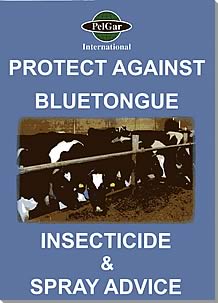21/07/08
Insecticide manufacturer PelGar International has published a booklet on how to defend farm premises from the midges that carry the Bluetongue virus.
 |
“While the focus has been quite rightly on vaccination so far, this virus can be fought on two or three fronts,” suggests PelGar’s technical director Dr Jonathan Wade.
“Removing the places midges like to live, and applying Defra-approved insecticides in and around animal housing, the parlour and livestock vehicles, will reduce the chances of the animals being bitten in the first place.”
Midges breed in moist conditions in damp, muddy areas and in faecal and rotting vegetation. Slurry pits and dung heaps provide an ideal breeding ground for them.
The females usually stay within 20 metres of where they lay their eggs, which hatch after three to seven days. The larval stage usually lasts two to four weeks but can last several months, allowing them in some cases to over winter.
Adult midges live between one and 14 weeks. They are most active during the afternoon, dusk and at night, preferring warm, still conditions. The virus also replicates inside the midge quicker at higher temperatures – taking just three days at 28ºc and three weeks at 15ºc.
Lack of natural predators
“Unfortunately midges are not a natural food source for many animals or birds and bats do not eat enough of them to make a significant impact,” Dr Wade explains. “This is why we need to combine vaccination, movement restrictions and midge control to minimise the exposure to Bluetongue and limit its spread.
“Where practical, reduce their preferred habitat by storing manure away from livestock, and covering it if possible, as the resulting rise in temperature will kill the midge larvae. Scraping the edge of slurry pits to a depth of 6-10cm will also remove most of them.
“Spraying in buildings with an insecticide with known low mammalian toxicity, such as a synthetic pyrethroid, will greatly reduce midge numbers thereby cutting the risk of virus transmission. Defra also recommends treating the inside of vehicle compartments prior to transport to limit the potential spread of the disease.”
PelGar manufactures a range of Defra-approved insecticides to control midge populations – including Vulcan, a high powered, ready-for-use triple action fly spray, and Alphaban which is diluted with water before spraying; both can be used to treat buildings, equipment, machinery and vehicles.
The booklet gives more details of the available products and offers practical spray advice so that they can be applied correctly for greatest effect.
Copies of ‘Protect against Bluetongue’ are available free of charge by calling 01420 80744 or emailing office@pelgar.co.uk.
 Vaccinate Against BTV8 or Play Russian Roulette Vaccinate Against BTV8 or Play Russian Roulette
 RABDF Questions Government Bovine TB Funding RABDF Questions Government Bovine TB Funding
 Bluetongue Vaccine Decision Drives Forward Scottish Strategy Bluetongue Vaccine Decision Drives Forward Scottish Strategy

|





